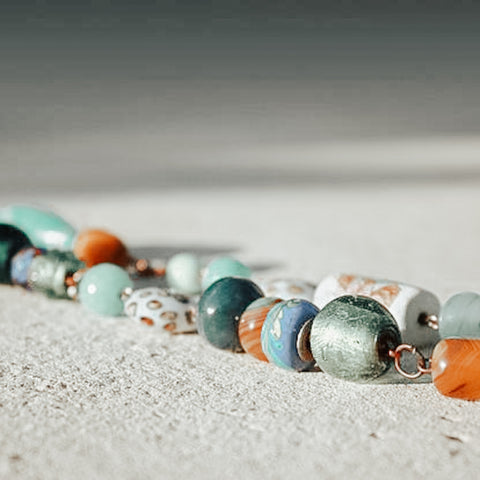Handmade jewellery. Shaped delicately and deliberately by skilled artisans all over the world, using techniques learnt over millennia. But what are the types of handmade jewellery? And what techniques are used to make them?
Let’s find out.
What is handmade jewellery?
Fashioned using handheld tools, raw metals (sometimes other materials too) and without the aid of premade parts, handmade jewellery is created by jewellery artisans across the globe with their bare hands.
This type of artisan jewellery, made by hand and not a machine takes time to be made. No two pieces are identical, but rather they are all beautifully imperfect with tiny variations in each design.
Each country, district or tribe have their own unique jewellery-making techniques. Native groups often pass down techniques to the younger generations and a further mix of cultural, societal and historical trends help to shape the techniques jewellery artisans use today.
What are the types of handmade jewellery?
Wire wrapped
Wire jewellery is an ancient jewellery-making technique, dating back thousands of years. No heat is applied to the metal in this technique; it is simply performed by bending and wrapping the wire across and over.
Some designs are more ornate with weaves and scrolls and others are a simple wrap across. Options range from plated wire with a copper core and sterling silver to 9ct gold and copper.
Beaded
This type of jewellery involves wood, plastic, glass or other type material beads with a hole in the centre which are strung on a thread or thin wire. The options are endless depending on your taste, from chunky materials like shells for a statement look or smaller, colourful resin beads for a more subtle pop of colour.
Silver and gold
These precious metals are malleable (once silver has been combined with another metal to form an alloy) so are shaped into rings, necklaces, anklets, earrings and various other items by artisans.
Goldsmiths and silversmiths shape the metal by hammering, soldering, casting, cutting and welding amongst other methods.
Glass
Using fused glass – glass which has been fused together in the kiln at a hot temperature, this type of handmade jewellery is made using hand tools and a myriad of glass colours. Often shaped into statement pendants, bracelets, beads, charms and rings.
Metal Clay
This certain type of clay solidifies once fired in a kiln and consists of tiny particles of metals like bronze, silver or gold that have been mixed with water and an organic binder.
Jewellery makers mould and shape the clay with tools by hand then fire it in the kiln, solidifying the clay. During the heating process the size of the piece reduces by up to a third of the size.
The material left after the heating process is a pure version of whatever precious metal particles are within the mixture. If you used silver metal clay you will be left with an item that is 99.9% pure silver after.
Aquila Jewellery
Aquila jewellery specialise in handmade jewellery made in India and Indonesia. We use only the best quality 925 sterling silver for our silver collection, 9ct gold vermeil for our gold pieces and 18ct gold and 925 sterling silver in our mixed metal items.
Our jewellery exists outside the timeline of fashion, instead aiming to celebrate the adventure of travel and the rawness of nature.
Why is handmade jewellery important?
Handmade jewellery is valued for not only its craftsmanship but its longevity and the quality materials it is made from.
Supporting this unique jewellery industry helps independent brands and shops who bring fresh, new ideas into a saturated highstreet market where many pieces of jewellery look identical.
Much of the time, handmade jewellery is also ethical jewellery so is responsibly made, environmentally friendly and sometimes from recycled metals.
What are examples of handmade jewellery techniques?
There are different types of handmade jewellery the world over, created by anything from indigenous tribes to city-based UK silversmiths.
What differs is not always the types of jewellery, but the specialist techniques they use in their native jewellery making processes.
Here are some commonly found specialist techniques below:
Embossing
This process involves forming a raised design or texture on metal sheets (other materials are possible too). Debossing is the opposite, with the image being raised and the background being sunken. Both are done using hand tools.
Enamelling
This is a technique often found in Indian jewellery making and has a rich history dating back as far as the Romans. Enamel itself consists of a fused compound of base metal and powdered glass.
Silver or gold metals are coated with enamel which once hardened forms a smooth coating. Enamel can be made in any colour imaginable.
Our Hella pendant range exhibits the enamelling technique by our Indian artisans.
Filigree
With its roots in ancient Greek and Italy, filigree is a delicate jewellery-making technique where tiny metal beads and thin threads of metal, for example sterling silver, are arranged on a flat piece of jewellery such as a ring to create ornate decorative designs often symmetrical in their appearance.
The base metal undergoes an oxidation process so that the shine and lustre of the filigree contrasts with that of the metal below.
It is a frequently used technique in Indonesia, particularly Bali, so much so that it has become synonymous with their jewellery culture. Our product (Agra ring) displays filigree at work by our skilled Indonesian artisans.
The Aquila Jewellery range also displays many other Indonesian silversmithing techniques in our collections.
All in all…
Handmade jewellery carries individual traits from the artisans that make it as well as the country and culture it comes from. Next time you are in an independent handmade jewellery shop why not stop to take a close look at some pieces. Perhaps you can identify some techniques and even spot where it was made?
Are you a fan of handmade jewellery? What types and techniques are you drawn to? Let us know in the comments.









